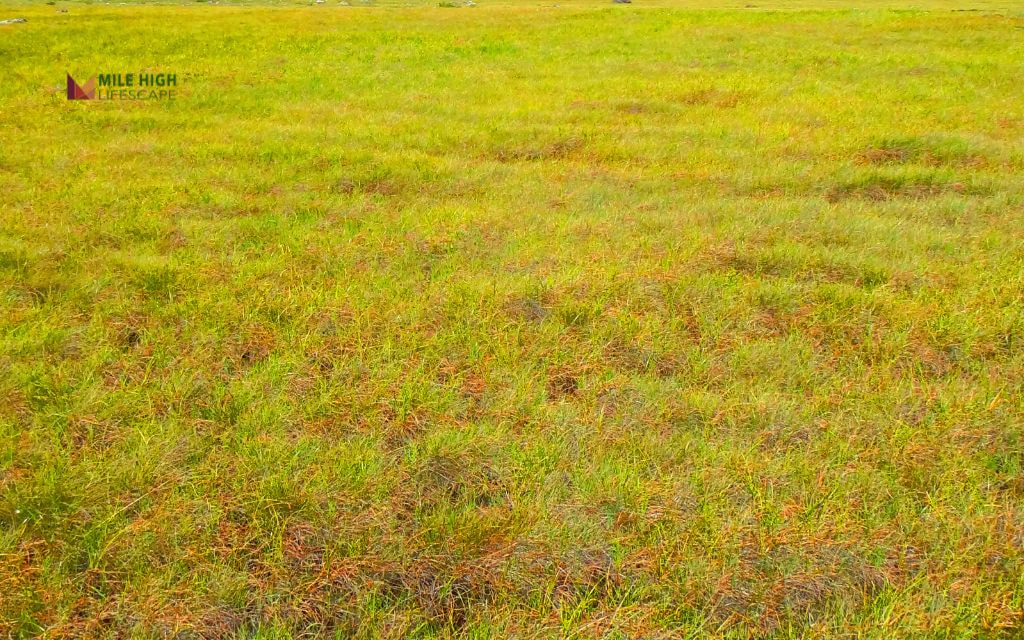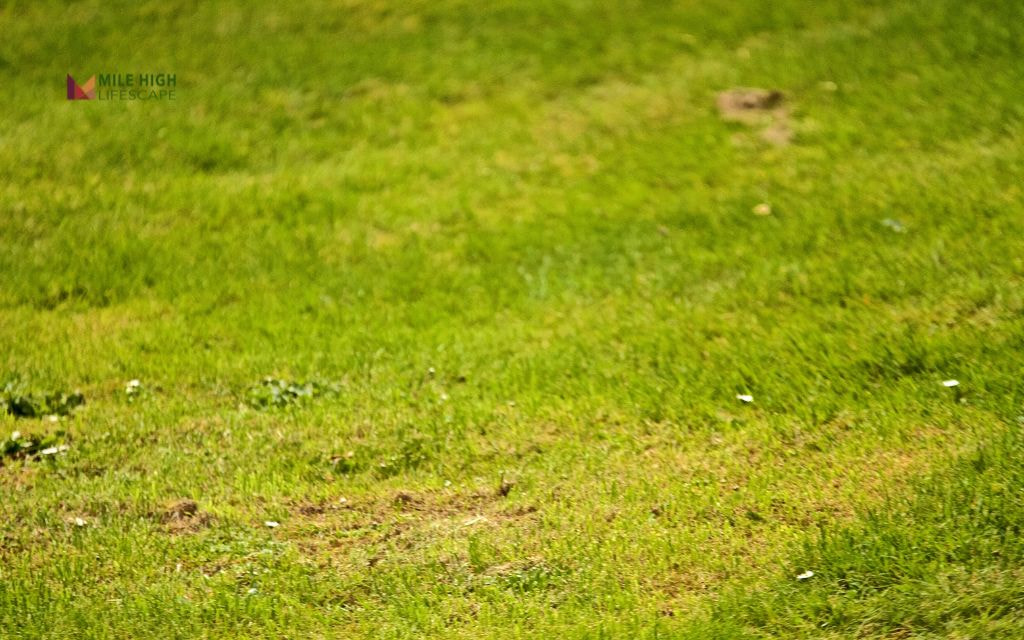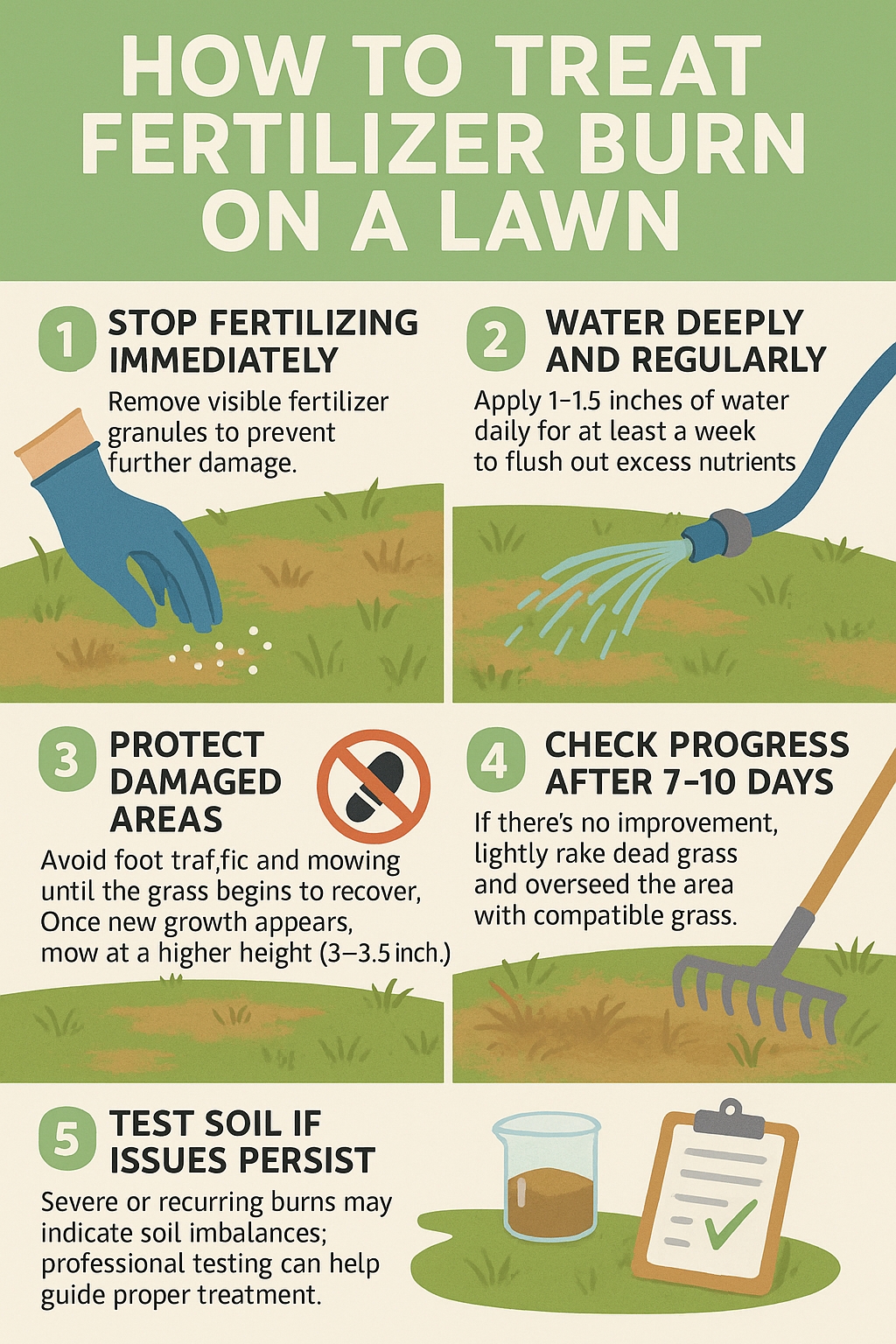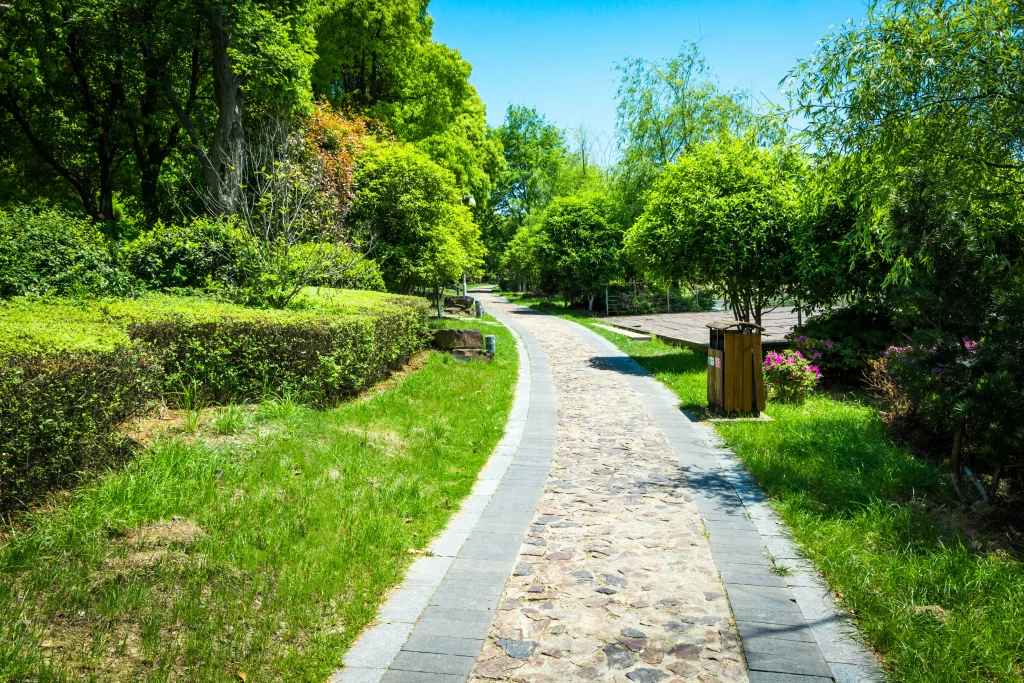Fertilizer burn lawn occurs when excessive nutrients damage grass through chemical overload, creating visible yellow or brown patches across your lawn. This common issue affects many Denver homeowners due to our region’s dry climate and varied seasonal conditions.
Understanding how to recognize, address, and prevent this lawn damage will help you maintain a vibrant yard throughout the year. This guide walks you through the complete process of lawn recovery, from identifying the problem to implementing effective solutions tailored to Colorado’s unique growing conditions.
What Is Fertilizer Burn Lawn?
Lawn fertilizer burn happens when excessive fertilizer is used, causing elevated nitrogen and salt concentrations in the soil, which can harm or kill the grass. This often leads to unsightly yellow and brown patches or strips of dead grass. The two main causes of fertilizer burn on lawns are dehydration due to salt and nitrogen problems within the fertilizer:
- The Salt Dehydration Process: Fertilizer burn lawn happens when excess salts from lawn fertilizer draw moisture out of grass plants. This dehydration process damages grass at the cellular level, similar to how salt preserves food by removing water. When concentrated fertilizer contacts your lawn, its high salt content pulls water from grass blades and roots through osmosis, essentially drying out the plant tissues from the inside.
- Problems With Nitrogen: Most lawn fertilizers contain nitrogen as their primary nutrient. While nitrogen helps grass grow green and lush, it can quickly harm your lawn when applied incorrectly. Fast-release nitrogen formulations dissolve rapidly after application, creating sudden spikes in soil salt concentration. Unlike slow-release products that feed grass gradually over time, these quick-release formulations can overwhelm grass plants when not properly watered in or when applied too heavily.

Signs of Fertilizer Burn on Your Lawn
Identifying fertilizer burn lawn damage early allows for quicker intervention and better recovery outcomes. Most symptoms appear within 1-7 days after application, with severity depending on the fertilizer concentration and environmental conditions.
Common Visual Symptoms:
- Yellow or brown patches with clearly defined edges
- Discoloration that follows spreader patterns (often appearing as stripes or consistent tracks)
- Brittle, crispy grass blades that break easily when touched
- Root discoloration and shriveling beneath affected areas
- Uniform damage across multiple grass species in the same area
The timing of symptom appearance provides additional clues. Fertilizer burn lawn damage typically develops shortly after product application, whereas fungal issues develop more gradually and inconsistently across the lawn. In Denver’s climate, the quick transition from healthy to damaged turf within days of fertilizing strongly suggests burn as the primary cause.

How to Treat Fertilizer Burn Lawn?
When you notice fertilizer burn, implement these recovery steps immediately:
- Stop fertilization completely. Remove any visible fertilizer granules from the lawn surface by gently raking or sweeping affected areas. This prevents further nutrient absorption and gives damaged grass a chance to recover without additional stress.
- Water deeply and frequently. Apply 1-1.5 inches of water daily for at least one week to flush excess nutrients from the root zone. In Denver’s climate, morning watering (before 10 AM) provides maximum effectiveness while minimizing evaporation loss. Continue until symptoms begin improving.
- Protect damaged areas by restricting foot traffic and suspending mowing until recovery begins. When grass shows signs of new growth, maintain a higher mowing height (3-3.5 inches) to reduce additional stress and promote recovery through increased photosynthesis.
- Evaluate recovery progress after 7-10 days. For areas showing no improvement, light raking to remove dead material followed by overseeding with compatible grass varieties may be necessary.
- Test soil conditions if burn was severe or recurs despite proper application. Denver’s naturally alkaline soils may require specific amendments to optimize nutrient availability and prevent future burning. Professional soil testing provides precise recommendations for your specific lawn composition.
The key to recovery lies in consistent moisture management.
Denver’s low humidity and intense sunshine increase evaporation rates, so monitoring soil moisture daily during recovery ensures damaged roots receive adequate hydration to rebuild cellular structures and resume normal growth patterns.

How to Prevent Fertilizer Burn Lawn in the Future?
Implementing these preventive practices will significantly reduce future fertilizer burn risk:
- Follow application guidelines precisely. Read product labels carefully and measure your lawn’s square footage accurately to calculate the correct application rate. Never exceed recommended amounts, even on struggling lawns.
To prevent fertilizer burn, consider alternative lawn care approaches. Organic options minimize burn risk while improving soil health. For example, using the Best Organic Lawn Fertilizer can provide nutrients gradually and safely. This approach supports a healthy lawn without the harsh effects of chemical overload.
- Choose appropriate fertilizer formulations. Opt for slow-release or controlled-release products with lower nitrogen percentages (below 20%) that disperse nutrients gradually. Organic alternatives like compost tea or natural fertilizers present minimal burn risk while building soil health progressively.
Choosing the right fertilizer is crucial, especially if you have pets. Many conventional fertilizers can be harmful to animals, leading to health issues if ingested. For homeowners concerned about their furry friends, exploring Pet Safe Lawn Fertilizers offers safer alternatives to maintain a healthy lawn without compromising pet safety.
- Water strategically after application. Apply 0.5-0.75 inches of water immediately after fertilizing, then maintain consistent soil moisture for 3-5 days afterward. In Denver’s climate, this often requires adjusting irrigation schedules temporarily to account for fertilizer presence and higher water needs.
- Time applications optimally. Avoid fertilizing during high temperatures (above 85°F) or drought conditions. In Denver, early spring (April-May) and early fall (September-October) provide ideal application windows when moderate temperatures and natural moisture patterns support proper nutrient integration.
- Invest in quality equipment. Use calibrated broadcast or drop spreaders rather than hand-spreading to ensure even distribution. Walk at a consistent pace during application and overlap slightly between passes to prevent striping while avoiding concentrated application.
- Consider professional service. Lawn care professionals understand local soil conditions, appropriate product selection, and application timing specific to Denver’s microclimate zones. Their expertise significantly reduces burn risk while optimizing nutrient availability for your specific grass varieties.
Implementing these preventive practices will significantly reduce future fertilizer burn risk. For optimal timing of fertilizer application, refer to our Lawn Fertilizer Schedule to ensure your lawn receives the right nutrients at the right time. Read product labels carefully and measure your lawn’s square footage accurately to calculate the correct application rate.

Preventing fertilizer burn is crucial for maintaining a healthy lawn. Understanding the correct application rates is key. For a more in-depth guide on determining How Much Fertilizer for Lawn you really need in Denver, refer to our comprehensive article. This will help you avoid over-fertilization and keep your lawn lush and green.
Conclusion
Addressing fertilizer burn lawn requires prompt action and proper techniques to restore grass health. By recognizing the telltale signs of yellowing or browning patches after fertilization, you can quickly implement recovery measures including thorough watering, temporary suspension of fertilization, and potential overseeding for severely damaged areas.
Prevention remains the best strategy – using slow-release products, following application instructions precisely, watering appropriately, and timing applications during optimal seasonal windows will significantly reduce burn risk.
Contact our Mile High Lifescape team today at (303) 877-9091 for a comprehensive lawn health assessment to establish a maintenance plan that promotes healthy growth while preventing future fertilizer damage.
